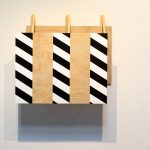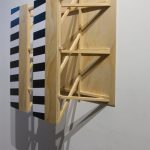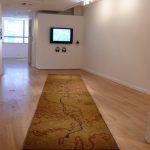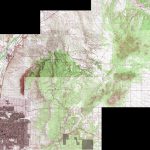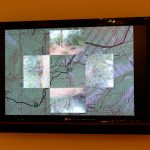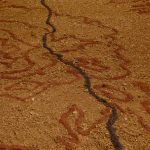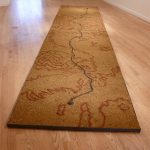“Judy Marsh’s paintings use the visual language of the structures that shape our movement in the urban environment, particularly of hazard signs and barriers. In these sculptural paintings strips of black and white diagonal stripes protrude forwards with an arresting vibrancy. Left open at the side, the works invite the viewer to peer between the panels – filled with carefully executed scaffolding, these sections speak to the in-between spaces that emerge when two barriers are erected.” (credit)
Category Archives: Commuting
Bill Gilbert, Walk to Work (2009)
“For twenty-two years I have made the hour long drive from my house in Cerrillos to my office at the University of New Mexico. For this piece, I decided to walk to work. I strapped on a backpack, headed out my door and walked as straight a line as possible (given the variations in topography, land ownership, etc.) to my office at UNM. Along the roughly 50 mile trek across ranch land, the Sandia Mountains and the northeast quadrant of Albuquerque I recorded my perceptions from the perspective of a lone hiker walking across the land.
This work is part of a series of “Physiocartographies.” Started in 2003 in the field with the Land Arts of the American West mobile studio, the physiocartographies series combines the abstraction of cartographic maps with the physical act of walking the surface of the planet to create portraits of place. In the various works from this series I follow prescribed paths across the landscape using a gps unit to navigate and record points, a camera to shoot images and a digital recorder to capture sounds. The final works appear as reconstructed maps, videos and installations.” (credit)
Diane Borsato, Touching 1000 People (2001-2003)
”
Amish Morrell, Henri Fabergé, Christine Atkinson, Epic Ravine Marathon (2015)
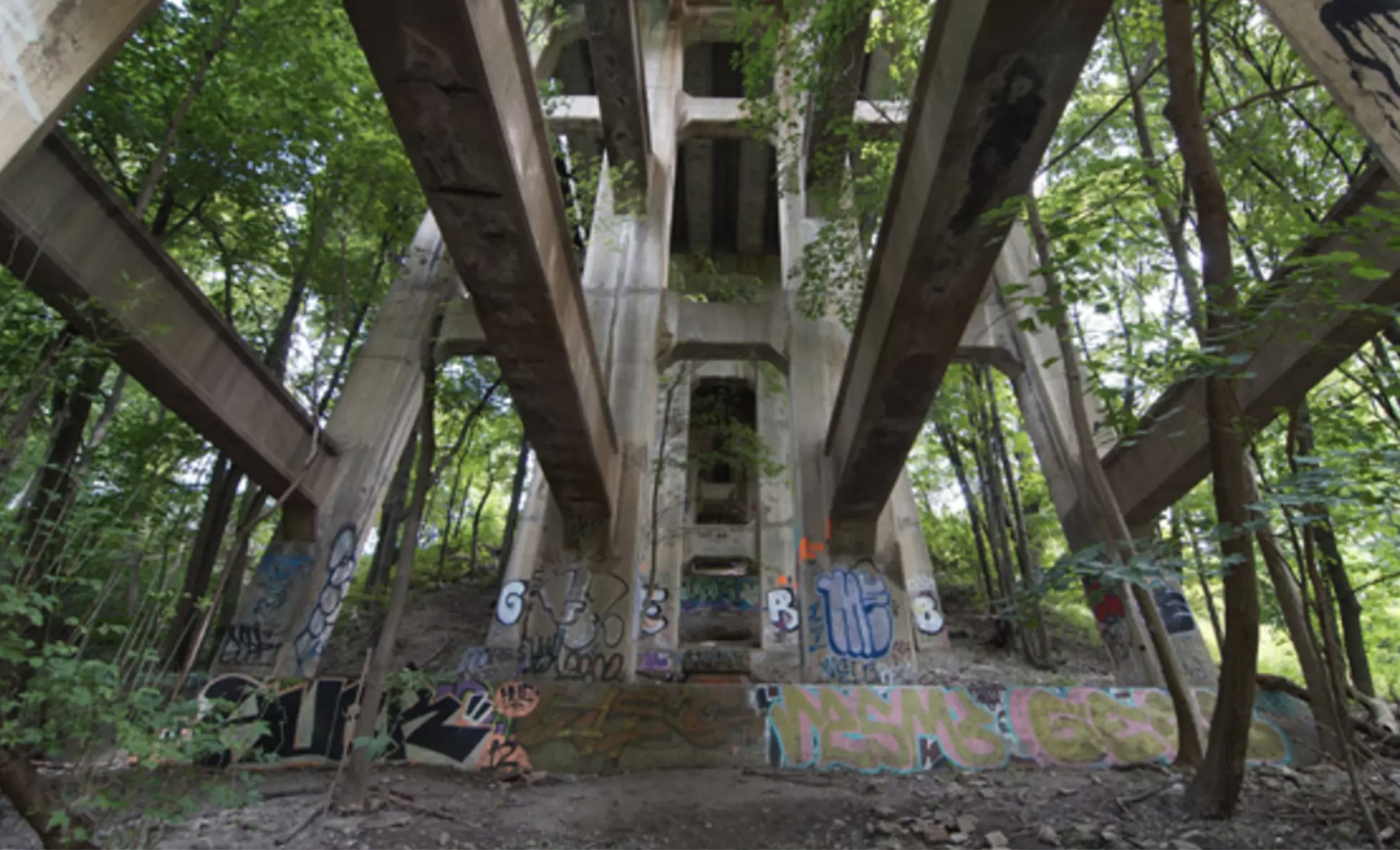
ravine
“On November 15, 2015, more than thirty people, including artists, adventure racers, casual joggers, track champions, walkers and other members of the general public, ran from Old Mill subway station in Toronto to Sherbourne subway station, following four major urban watersheds. The route followed the Humber River from Bloor Street to the Black Creek, crossed the North York hydro corridor north of Finch Avenue, joined the West Don River and followed the main artery of the Don River to the finish at Bloor Street, passing under Highway 401 twice. Covering fifty-five km in total, the route took more than 9 hours and almost entirely followed riverbanks and ravine trails. Two people finished the entire distance.”
Credit: Morrell, Amish and Diane Borsato. Outdoor School: Contemporary Environmental Art. Douglas and McINtyre, 2021. Page 62.
—
“Toronto’s ravine system provides city-dwellers with an urban oasis that’s not often explored. But on Sunday, a small group of Torontonians will run a day-long marathon through these expansive green spaces.
Organizer Amish Morrell, who’s the editor of C Magazine, says these runs aren’t competitive. “It’s not a race at all, it’s really an adventure.”
Morrell notes that his friend and performance artist Henri FabergĂŠ started doing conceptual running routes a few years ago. Together, along with artist Jon McCurley, they ran from Kipling to Kennedy (35 kilometres above ground).
About a year ago, Morrell mapped out a marathon route through Toronto ravines – areas that he regularly explores and runs through. He even cross-country skies the ravines in the wintertime. “A lot of this kind of evolved out of finding different ways of moving through the city,” he says.
For Sunday, he’s planned a 55 kilometre trek between the Black Creek, Finch Hydro Corridor and Don River sections of the ravine. “I would say 90 per cent of it is trail in the ravines and about 50 per cent of that is totally kind of secret, clandestine paths,” though Morrell stresses that the event may not be for everyone.
“It’s a pretty DIY, kind of punk event,” he says. Anyone who decides to join needs to be well-prepared with proper equipment and supplies – a detailed list can be found on the Epic Ravine Marathon Facebook page.
And, don’t expect a timed race. “Our motivations are more about exploration, curiosity, discovering places and learning things about them,” says Morrell. He knows the distance may be daunting and expects many of those who join his small group will tag along for the first 10 to 15 kilometres.
Morrell says that while most of the route is accessible via the TTC, being the in the ravines provides an alternate way to view Toronto. “It totally shifts and transforms your experience of the city.”
Hui-min Tsen, The Pedway (2009-13)
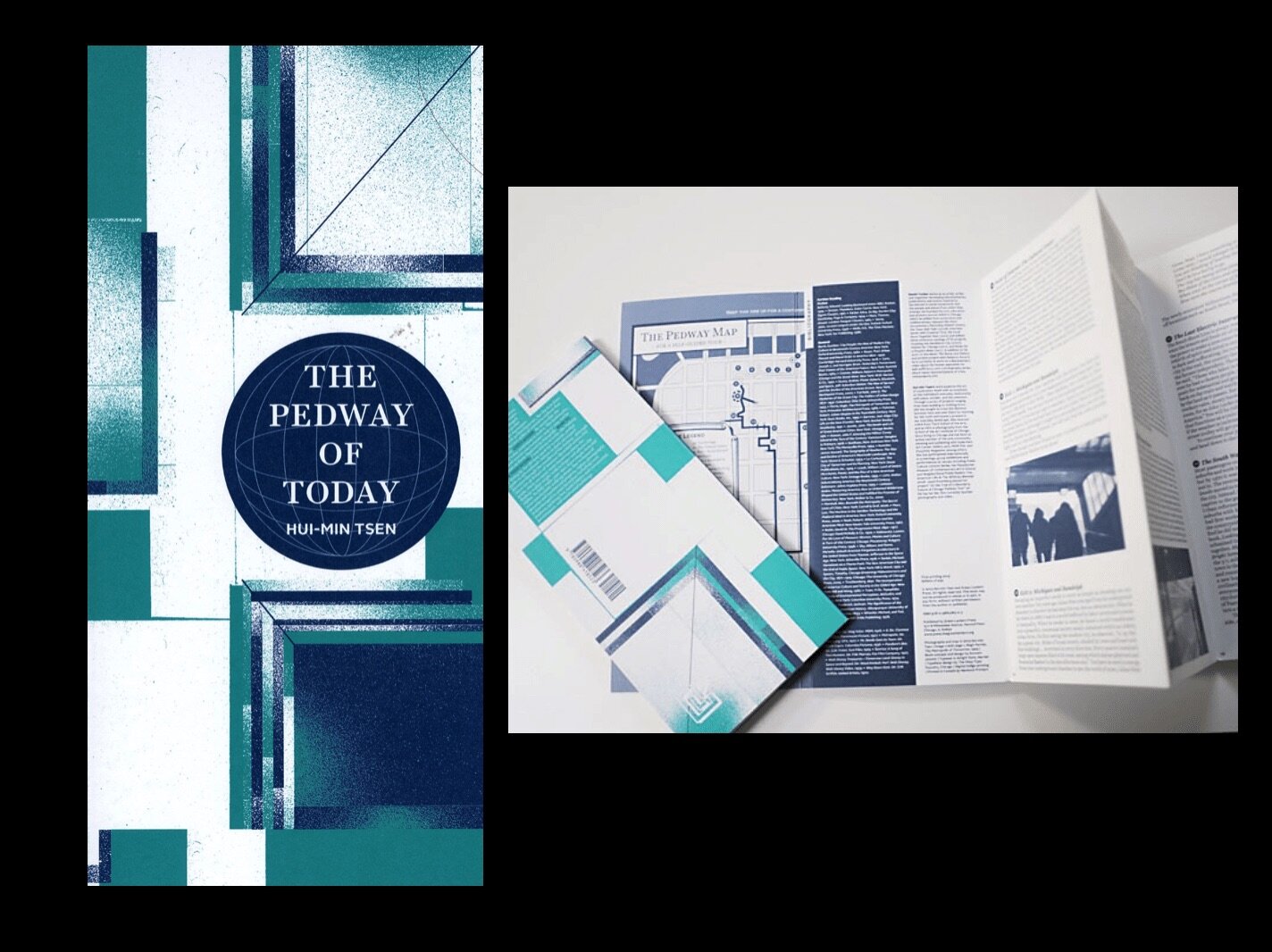
published 2013 by Green Lantern Press | Specs: 18 pages, 4.2 x 0.2 x 9 inches
“Deep beneath the surface of the city, a tangled ribbon of corridors runs throughout 40 blocks of downtown Chicago. This meandering passage appears to have grown up organically as if it were an animal’s burrow or a donkey’s path. Its route is illogical: the corridors exist outside of known space, and its hidden entrances lead to mysterious destinations. What is this place? It is the Chicago Pedway, an intricate non-system of pedestrian tunnels built to separate the citizens of the city from the dangers and foul weather encountered on the street.
On the Trail of a Disorderly Future was an interdisciplinary project consisting of a walking tour of Chicago’s Pedway, ephemera given and sold to tour participants as souvenirs, and a book for a “self-guided” tour of the Chicago Pedway. The project told a story across 36 points-of-interest, weaving together mythic and historical tales to tell the story of urban development, utopian impulses, and fears of the city from the Renaissance until now.
Details: Active from 2009-2013 | performance (90-minute walking tour), ephemera (postcards, map, website), book” (credit)
Paul-Henry Chombart de Lauwe, Trajets pendant un an d’une jeune fille du XVIe arrondissement (1957)
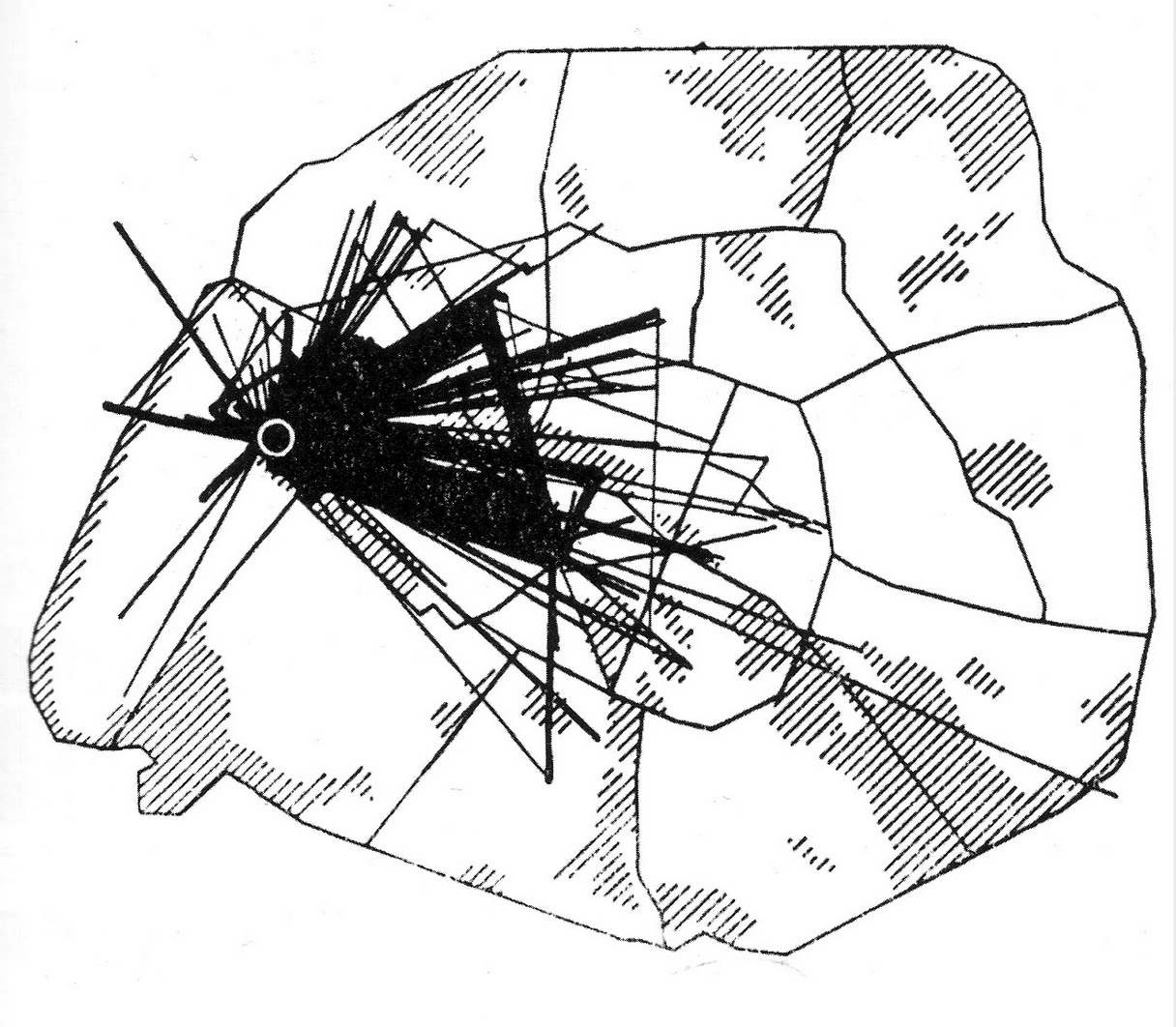
Situationists’ maps combined objective with subjective. This idiosyncratic map is based on the movements of a single individual studying at the school of political science. A triangle emerges — the vertices are the residence, the university and the home of a piano teacher.
Adrian Piper, I am the Locus #2 (1975)
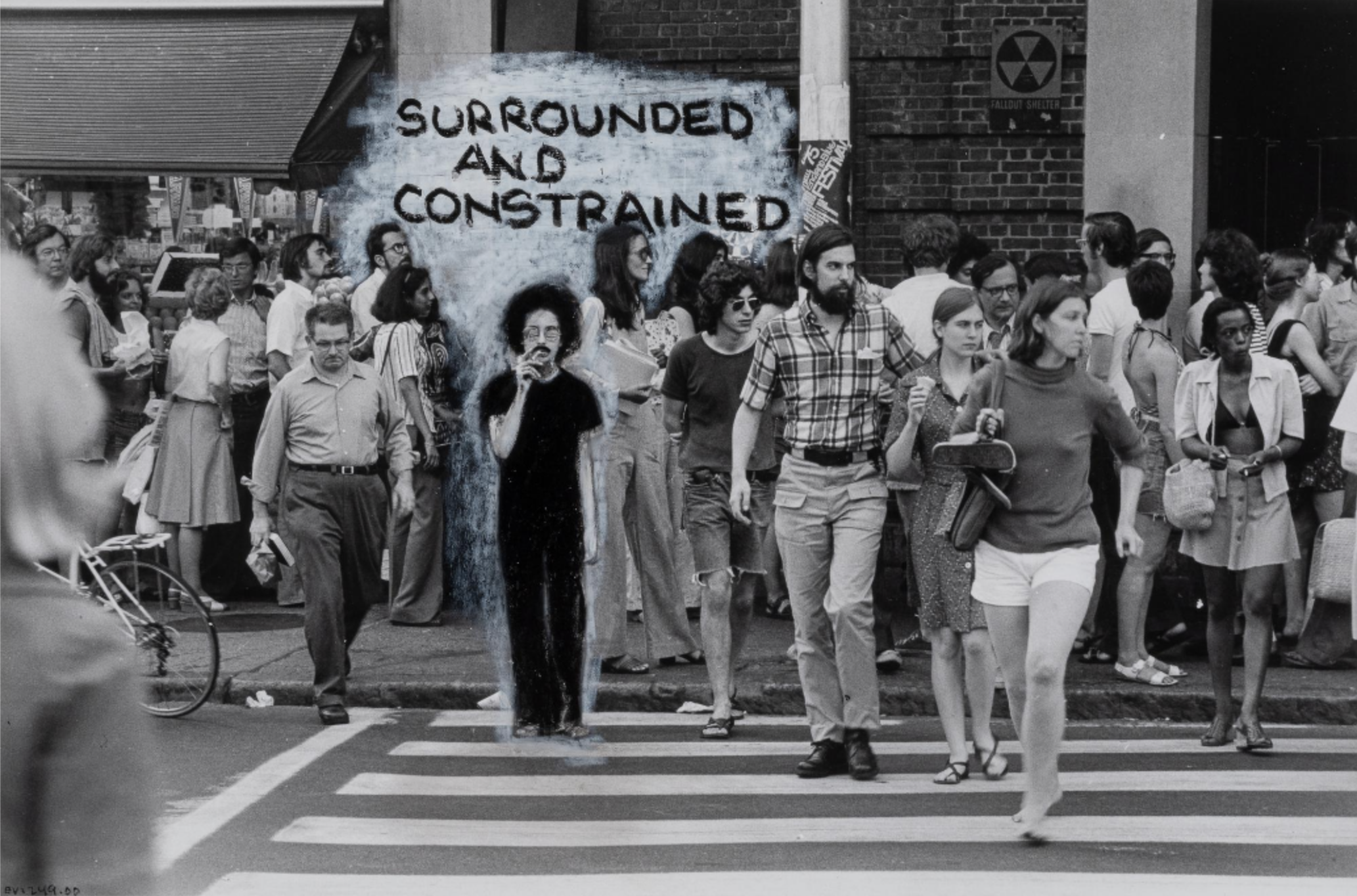
[credit]
I am the Locus (#2)
DimensionsSheet: 8 x 10 in. (20.3 x 25.4 cm)
“The series of five hand-worked photographs that comprise The Mythic Being: I am the Locus conveys Piper performing a consciousness of otherness on a walk through Harvard Square in Cambridge, Massachusetts. An American-born artist of mixed racial background, Piper has articulated questions about the politics of racial identity in many ways throughout her work as an artist and philosopher. In 1973, Piper created an alter ego, the Mythic Being, who became the basis of a pioneering series of performances and photo-based works. For this 1975 Mythic Being performance, she sported large sunglasses, an Afro wig and mustache—chosen to blend in with the mid-seventies urban environment, and dressed in men’s clothing. This simple costume enabled her to appear inconspicuously as a black man to an unknowing public. In these photographs we can perceive the indifference of the crowd in Harvard Square to Piper’s performance: people brush shoulders with her, or look in the opposite direction.
Her subsequent intervention into the photographs with oil crayon and text helps to dramatize the scenes, and to express the tension between the artist’s inner experience and the invisibility of her Mythic Being performance to its live audience. Drawing directly on the photographic prints prevents the images from being seen as straightforward documentation of a performative event. Instead, by the final sequential image, most of the other people and surroundings have been obliterated by drawing, which parallels the text’s shift from philosophical meditation (“I am the locus…”) to existential shove (“Get out of my way…”). Piper intended for these photographs to be made into posters; she did not initially intend for these preparatory images to be treated as works of art unto themselves.” [credit]
—
“In 1973 Adrian Piper pasted a mustache on her face, put on an Afro wig, and donned round, wire-rimmed shades.
Dressed and acting like a man, she went out into the streets.
Muttering passages she had memorized from her journal, the artist was startling and weird, challenging passersby to classify her through the lens of their own preconceptions about race, gender, and class.

Who was this light-skinned black man, going on and on about how his mother bought too many cookies. Was he crazy? Was he dangerous? Why was he being followed by a film crew?
These street actions formed the basis of The Mythic Being, an influential work of performance art that helped establish Piper’s reputation as provocateur and philosopher.
At a time when Conceptual and Minimal art were mostly male domains that pushed to reduce art to idea and essence, Piper pushed back with confrontational work that brought social and political issues to center stage. And at a time when most performances were barely documented, Piper announced her project in ads in the Village Voice, arranged for it to be filmed by Australian artist Peter Kennedy, and created works on paper dominated by her aggressive alter-ego.
In the catalogue for “Radical Presence: Black Performance in Contemporary Art,” currently at NYU’s Grey Art Gallery, curator Naomi Beckwith describes Mythic Being as “a seminal work of self-fashioning that both posited and critiqued models of gender and racial subjectivity.”

Footage from Mythic Being, borrowed from Kennedy, had been playing on a monitor in the Grey’s galleries until this week—when Piper requested the work be removed. The monitor was turned off and the gallery posted a note to viewers on top.

It explained that the artist had articulated her reasons in correspondence with Valerie Cassel Oliver, the show’s curator, which reads in part:
“I appreciate your intentions. Perhaps a more effective way to ‘celebrate [me], [my] work and [my] contributions to not only the art world at large, but also a generation of black artists working in performance,’ might be to curate multi-ethnic exhibitions that give American audiences the rare opportunity to measure directly the groundbreaking achievements of African American artists against those of their peers in ‘the art world at large.’”
The note responds with a statement of Cassel Oliver’s from the catalogue, arguing that the show’s mission is to resist “reductive conclusions about blackness: what it is or what it ain’t. What is clear is that it exists and has shaped and been shaped by experiences. The artists in this exhibition have defied the ‘shadow’ of marginalization and have challenged both the establishment and at times their own communities.”

In response to Piper’s request, Cassel Oliver added: “It is clear however, that some experiences are hard to transcend and that stigmas about blackness remain not only in the public’s consciousness, but also in the consciousness of artists themselves. It is my sincere hope that exhibitions such as Radical Presence can one day prove a conceptual game-changer.”
In depriving students and the larger public from seeing her work at the Grey, the artist, who currently lives in Berlin and runs a foundation dedicated to art, philosophy, and yoga, has chosen to make a larger point about marginalization and otherness, themes that have dominated her work throughout her career.
The question is whether separate exhibitions are still needed to tell the stories that were left out and continue to be absent from conventional tellings of art history, or whether creating these separate spaces amounts to a kind of ghettoization that prevents the artwork from being considered on the larger stage.

These issues are hardly confined to race, of course—curators of exhibitions on gender, nationality, and other aspects of identity routinely encounter artists who decline to participate because they don’t want to be considered in the context of “women artists,” “Jewish artists,” and so on. So, sometimes, do our contributors and photo editor when we run stories on these issues.
The organizers of “Jew York,” a show at Zach Feuer and Untitled galleries in New York last summer, were turned down by several artists who didn’t want to appear under such a rubric. Luis Camnitzer, a German-born Uruguayan artist, was so conflicted that he couldn’t decide whether to recuse himself or contribute a piece. So he sent a letter describing his conundrum, which became part of the show. It read in part: “Do I refuse the invitation on the grounds of feeling that it is an artificial and anecdotal grouping irrelevant to the work of most artists invited and therefore tinged by an aroma of weird fundamentalism? Or do I have to accept on the grounds of my need not to deny my Jewish connections bound by my ethical debt and beliefs? Maybe not totally pleasing to everybody, this letter tries to be my compromise.”

When “Radical Presence” opened at the Contemporary Arts Museum, Houston, last year, it also included five works from Piper’s 1975 series I am the Locus, collaged and painted Polaroids on which images of Piper as the Mythic Being are inserted into scenes of a crowded street. The text gets bigger as the figure approaches the viewer, culminating in the warning “Get Out of My Way, Asshole.” The works, owned by the Smart Museum at the University of Chicago, were deemed too fragile to travel to New York.
Part II of the New York version of “Radical Presence” opens at the Studio Museum in Harlem on November 14. It doesn’t include any works by Piper. The show is scheduled to travel to the Walker Art Center in Minneapolis next year.” [credit]
PJ Roggeband, Exhaust Garden (UITLAATTUIN) (2017-)
“Is there such a thing as portable green? What role can mobile nature play in the urban environment? The ‘Exhaust Garden’ offers a solution! Suppose you want to get away as a city dweller. You step into your portable garden, put on the shoulder straps and off you go: strolling through the busy city with your nose between the plants and grasses.”
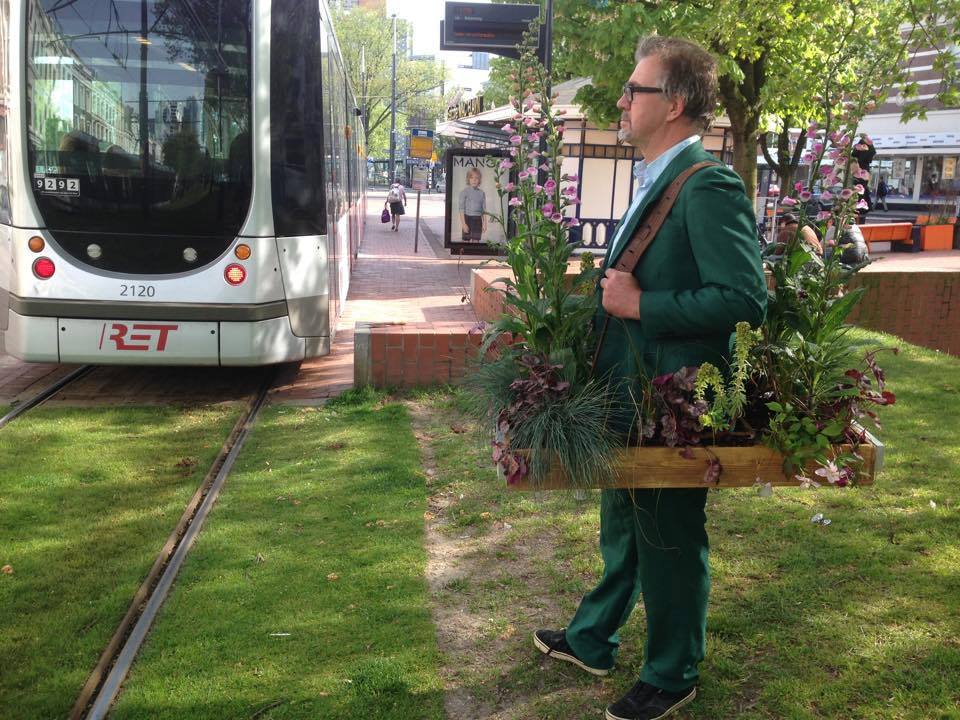
exhaust garden
“It all starts with a contribution to the ‘Hortus Conclusus’ exhibition in the Museum of Religious Art in Uden. In consultation with sculptor / landscape gardener Hans van Lunteren I make the ‘ENCLASS GARDEN’. The perspective within this portable garden has been reversed; it is nature that walls and shields man. The motif of the enclosed garden refers to the Garden of Eden or the Earthly Paradise where man lived in harmony with nature. The approach to paradise as something small and personal opens up interesting possibilities, of course.
Man destroys nature, man protects nature. The artists have played with this fact. They have reversed the perspective. With them, man is enclosed in a portable garden; the Homo Hortus Conclusus.
The square meter garden regularly goes outside, into nature, around the shoulders of people. The exuberant garden. Later versions of the ‘ENCLASS GARDEN’ have been developed specifically for the theme of an exhibition or respond to current events.”
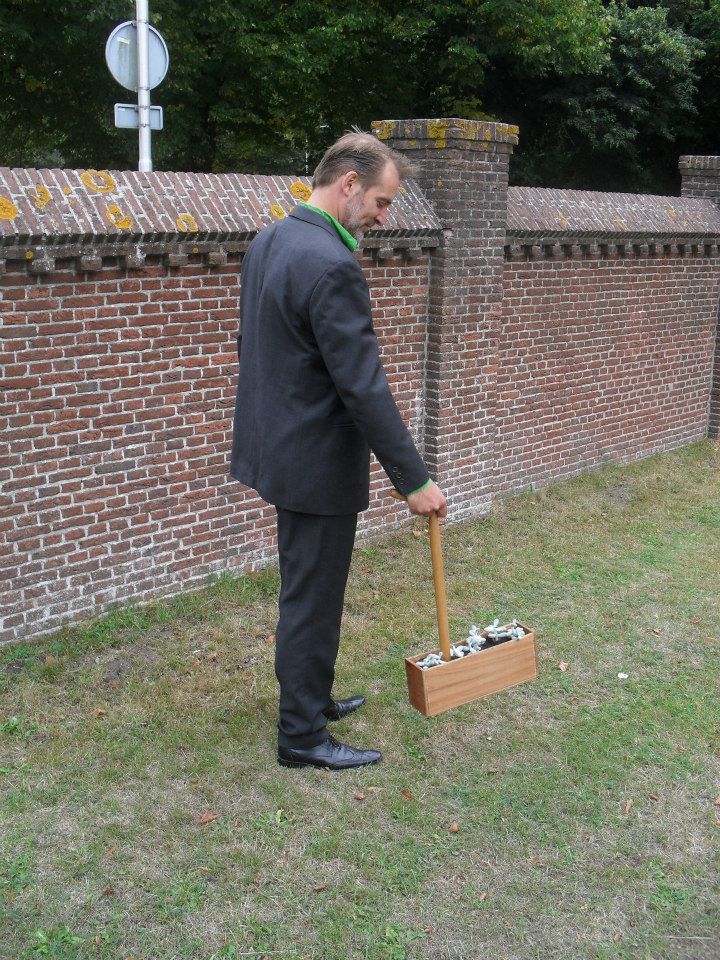
UITLAATTUIN-model-succulent
“When I notice a part of a hoe with the striking handle in addition to a wooden container intended for chalks and erasers among the waste at a primary school, a more manageable form of the ‘OUTLET GARDEN’ is born.
The ‘EXHAUST GARDEN’ has a wealth of possibilities. You can fill it with all kinds of herbs, vegetables or plants. You can of course make a statement by using your portable garden for endangered bees and butterflies. But you can also turn your garden into a mobile weather station, for example, by using guichelheil. Because the flowers of this plant close quickly when bad weather is on the way, guichelheil is also used as a (poor man) barometer.” [credit]
Walk & Squawk, The Walking Project (2003-2006)
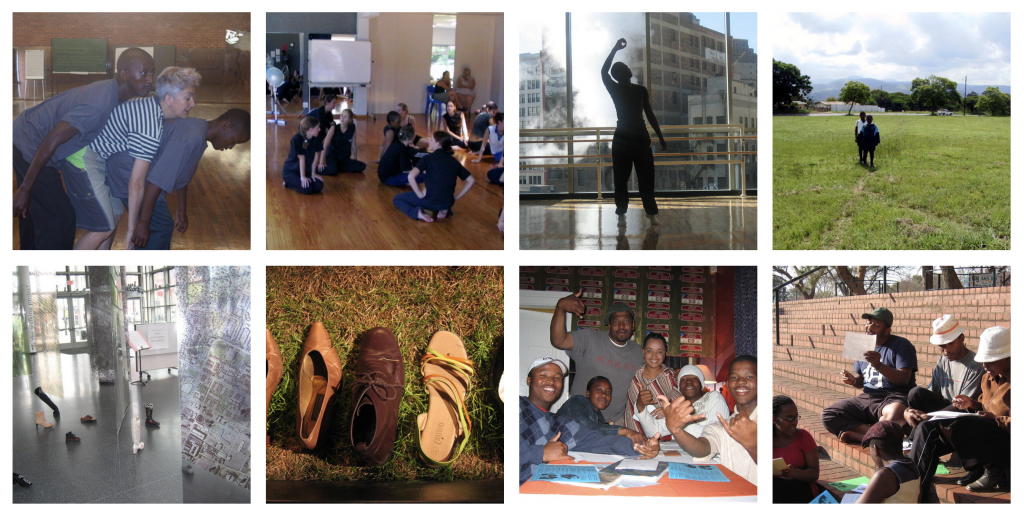
Walk and Squawk, The Walking Project (2003-2006)
“The Drawing Project began in Detroit in 1999 and became an interdisciplinary performance, mapping and cultural-exchange project collaboratively developed by Walk & Squawk (Hilary Ramsden and Erika Block), with U.S. and South Africa-based artists and communities during a series of residencies in Detroit and KwaZulu-Natal from 2003 through 2006. Inspired by desire lines people made across vacant lots in Detroit and across fields in South Africa we explored the paths we walk and how they are formed through culture, geography, language, economics and love. We looked at how changing our patterns of movement can alter our attitudes and perception, how taking a different path can alter our lives. We discovered how learning language alters the actual paths in our brains and how taking a car means something very different from taking a walk.” [credit]
Stuart McAdam, Lines Lost (2013-14)
“A project tracing the routes of branch lines that were cut following the Beeching Report in 1963
Stuart McAdam came to Huntly in Summer 2013 from Glasgow.
Stuart’s Lines Lost project was triggered by the infamous railway cuts which saw train tracks closed as a result of Dr Richard Beeching’s recommendations 50 years ago. Through a series of performative walks with all kinds of people along the former Portsoy to Huntly route, McAdam’s aim was to bring into focus the historic and contemporary concerns surrounding our transport legacy.
Through walking the former track again and again, people have seen him reawaken the route that has been subsumed into the landscape – like remains of ghostly traces of the line that once linked communities. Linking natural with industrial and social history of the past 50 years he interrogated the historical, cultural and contemporary resonances through a series of documented walks.
The North of Scotland was one of the areas most affected by the Beeching cuts with local stopping train routes such as Aberdeen – Inverurie, Aberdeen – Keith – Elgin, Huntly to Banff and Portsoy, Banff – Tillynaught, Fraserburgh – St Combs, Elgin – Lossiemouth, Aberdeen – Ballater and Fraserburgh, Maud – Peterhead and Aviemore – Elgin via Inverness, cut. Many of those that crossed the county have never been replaced by other forms of public transport making journeys difficult and adding hours to travel time for those not having access to private cars – passengers have to travel south to Aberdeen or north to Elgin to get connections often having long waits between buses. McAdam repeatedly walked the route from Huntly to Portsoy, experiencing it through different eyes every time.
“Physical and transparent remnants of most of the lines still exist within the landscape and I hope to reawaken them in the public consciousness”, said McAdam, who has explored journeys, boundaries and slow travel in a range of artworks.
“As we mark the 50th anniversary of the publication of the Beeching report is also fitting time to consider the impact that the cuts had on the relative development and decline of the many towns and villages that lay along the historic routes, routes that were often life lines for outlying communities.”
McAdam was at the Edinburgh Art Festival the 1st of August. For more information go to the event page.
Stuart also participated in the Room to Roam Festival” [credit]
